-
Posts
2,284 -
Joined
-
Last visited
-
Days Won
6
Content Type
Profiles
Forums
Blogs
Gallery
Events
Store
Posts posted by PKeating
-
-
There was probably never any reason, as such.
PK
0 -
I might be confusing you with someone else. I was selling 1st and 2nd Class Olympics decorations. Probably not you. No biggie.
Rgds,
PK
0 -
All of the Type 1 aluminium badges made in 1937 bore the C E Juncker hallmark. A few Type 2 aluminium badges from 1937/38 with the same hallmark are known but the majority are unmarked. Nobody has ever seen a Type 3 feinzink example from 1943/44 with a mark. Someone advanced the theory that the hallmarked Type 2s were sent for retail and, indeed, two of the known badges belonged to veterans who stated that they bought them as replacements. However, I don't think any inference should be drawn from this as the Type 1 issue badges in aluminium were hallmarked while the Type 1 and 3 badges in 800 silver which were strictly private purchases items bore no Juncker mark at all. The 1943/44 issue were probably all supplied directly to the OKH. Had any been supplied to retail outlets, they would doubtless have borne the firm's LDO L/12 code or, at that stage, perhaps even the PKA numerical code "2". Regarding production figures, Eric Queen and I based our conjecture upon research that indicated limited availability of doubles and replacements to recipients at the time.
The COA, by the way, has no value in itself other than as a curiosity piece attached to the badge.
PK
0 -
I am afraid that Hamburg dealers are hardly the yardstick by which one should judge originality, Phil. This badge does not conform in a number of ways to any known originals I have seen. The hinge is worrying but the Wehrmachtadler's head is even more troublng. I hope Vince did not pay too much for it. There again, as an object to dress a tunic mannequin, it is perfectly OK. Vince, didn't we do business before once? Were you not the guy who responded to some ads of mine, agreed a sale and then evaporated? Or am I confusing you with someone else?
PK
0 -
A grim aspect of the Great War indeed. Why do the guys in Rick's photograph remind me of modern-day Rentokil operatives? Imagine them in white vans with pest control equipment and baseball caps...
PK
0 -
There were three or four different makers. That much we do know. However, there are about fifteen variations at any given time offered by militaria dealers and "private" dealers. In other words, the majority of shields on the market are questionable.
PK
0 -
Thanks for the comparisons, John. Here's quite a wellworn example of the naval version of the shield, clearly struck on the same set of dies as the Heer/Luftwaffe version I posted above. I cannot remember who sent this to me but if the owner is looking in, I am sure he shan't mind my using it for discussion purposes here. The asymetric plinth is one point to look for. So is the dropped "9" in "1940". Vince's shield conforms more to a type attributed to the maker JFS. I will check my reference files as I believe I have some photos of JFS-marked examples.
PK
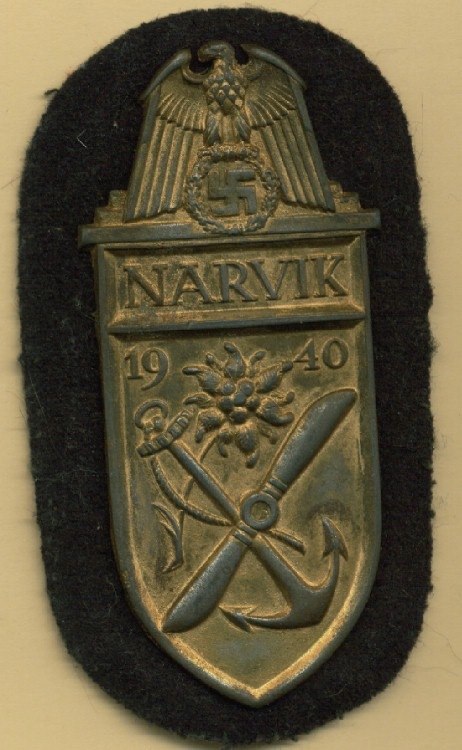
 0
0 -
Here is another Luftwaffe-issue Narvikschild, apparently of the same design as the ones shown here.
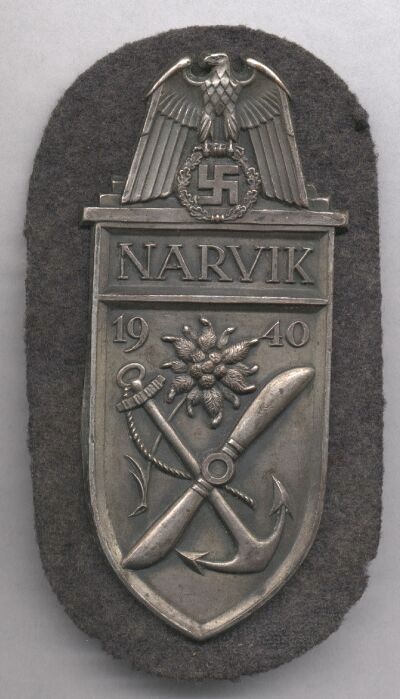
 0
0 -
The documents were issued at the end of the 1944 to men who had qualified during or before the summer of 1944. I have a paybook to an officer who qualified in the spring of 1944 and was one of the relatively few members of the battalion to receive the Army Parachutist Badge. His paybook contains a July 1944 date, just as his FSS bears a July 1944 date, but also shows an amendment to December 1944. The surviving members were by then with SS-Fallschirmj?ger-Btl 600, which seems to have received a batch of award documents from the SSFHA at the end of the year. I have seen two such documents, for the Army Parachutist Badge, one of which is to Walter Redeker and can be seen in Antonio Munoz's book Forgotten Legions. Oddly enough, despite years of searching, I have yet to see a Luftwaffe award document to a member of SS-FJ-Btl 500. I know there are a couple out there, including the one to Walter Hummel whose FSS I have, but attempts to trace them have so far proved fruitless.
Returning to Leigh's paybook, Page 4 contains an interesting entry for Fallschirm-J?ger-Ersatz- und Ausbildungs-Regiment 2, giving its location as N?rnberg-Buchenb?hl. This was where Fallschirm-J?ger-Ersatz-Bataillon 3, which provided replacements for 5. FJD, was based. Fallschirm-J?ger-Ersatz- und Ausbildungs-Regiment 2 was ordered to be formed in October 1943 and began forming in France in February 1944. The unit was subsequently reformed at Wittstock on 1.1.1945. Fallschirm-J?ger-Ersatz-Bataillon 3 was formed in November 1943 at Wittstock, which was the home base at the time of Fallschirmshule IV. The two dates at the top of the page in the same handwriting suggest that Friedrich Soder or Roder [is this his surname] was with Fallschirm-J?ger-Ersatz- und Ausbildungs-Regiment 2 from October 1943 to October 1944. If the prior date is an error and ought to have been "1944", then our man spent just twenty-four hours there. Yet on Page 3, there is a promotion dated 1.8.1944 bearing the Flieger Horst Kdtr Neuberg unit stamp. So the 22.10.1943 entry on Page 4 must be a clerical error, especially as the Flieger Horst Kdtr Neuberg pay office signs off in September 1944 on Page 11 and he handed his kit in on 2.10.1944. The unit details at the bottom of the page also appear to contain an error in terms of location. Both replacement units came under the Fallschirm-Armee umbrella and from January 1945 were on the ORBAT of the Fallschirm-J?ger-Ausbildungs- und Ersatz-Division, which was used as cadre for 20. Fallschirm-J?ger-Division in April 1945. Seems to have survived the war as his paybook cover is not crossed and no Roder or Soder appears in the German war graves register.
Interesting anomaly regarding the replacement unit.
PK
0 -
It's a good question, Chris. Barth could have worn a metal badge when he received or acquired one and perhaps he did. The reason for the cloth badge document is simple. Sometime during 1943, the OKL realised that a lot of newly qualified paratroopers were joining operational units and their award documents and presentation badges - in other words, the metal badges - were frequently taking months to catch up with them as units moved around. In many cases, guys were being killed without ever having received a badge.
Some guys who were lucky enough to go on leave before joining their units were able to buy badges. To give you some idea of how long it could take, members of SS-Fallschirmj?ger-Btl 500 who qualified early in 1944 did not receive their award documents until November and December 1944. Mind you, their documents and badges came through the SS-F?hrungs-Hauptamt, which might have been a bit slower in this respect than the relevant OKL office. Two fellows I knew told me that they had to buy their badges and, in one case, one of them had to go back to his billet to fetch his Fallschirmsch?tzenschein before Herbert Jobsworth's German cousin in the shop would sell him a Fallschirmsch?tzenabzeichen, even though he showed them the entry in his soldbuch.
So the authorities decided to award cloth badges, which were freely available from various unit and retail outlets as an interim morale-boosting measure, so that a fellow had something to wear on his chest when he passed out from the Fallschirmschule. The cloth badges were of course unofficial but permitted up to that point and the upgrade was recognised by the institution of this special award document. There was another type on A4 paper, folded in two, with a portrait of Hitler opposite the printed bit. This is the A5 type.
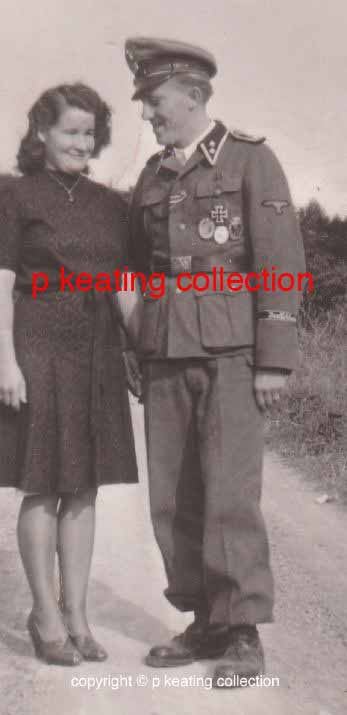
This portrait of Walter Hummel, who served with SS-Fallschirmj?ger-Btl 500 and, later, 600 was taken when he was on leave after completing his parachute training at Fallschirmschule III early in 1944. You can see the cloth badge on his tunic, given to him by the CO of the jump school after the last qualifying jump. Later photographs of Hummel show a metal badge.
PK
0 -
Fallschirmj?ger-Rgt 13 was destroyed at Saint-L? and reformed in Holland in November 1944. He was examined on 19.10.1944 and passed as fit for parachute training. Even though parachute training had been suspended in July 1944, recruits to parachute units still had to undergo the appropriate medical because it was envisaged that once Hitler had turned things around and they were marching towards victory again, all non-airborne members of airborne units would be sent to jump school. Furthermore, because of regulations, only men passed for parachute training could be issued with FJ kit so all new recruits to the Fallschirm-Armee being reformed in Holland late in 1944 were put through medicals in order to be able to wear the jumpsmocks, helmets and other kit. Your man was duly issued with a jumpsmock and other para kit in November 1944. He is described as arriving at 15./Fallschirmj?ger-Rgt 13 on 21.10.1944.
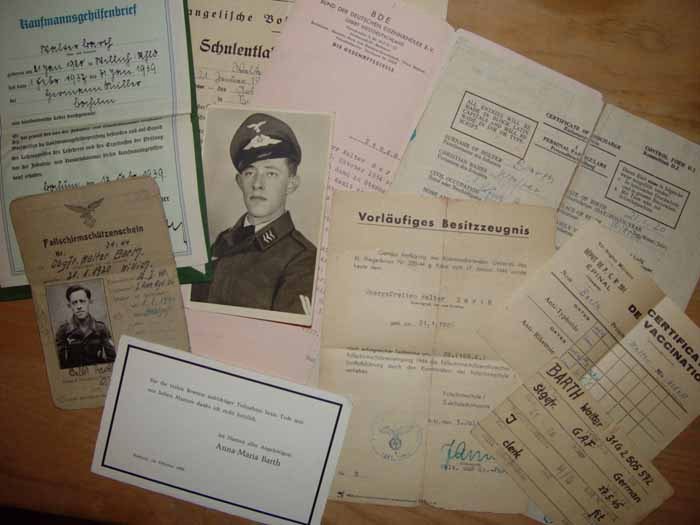
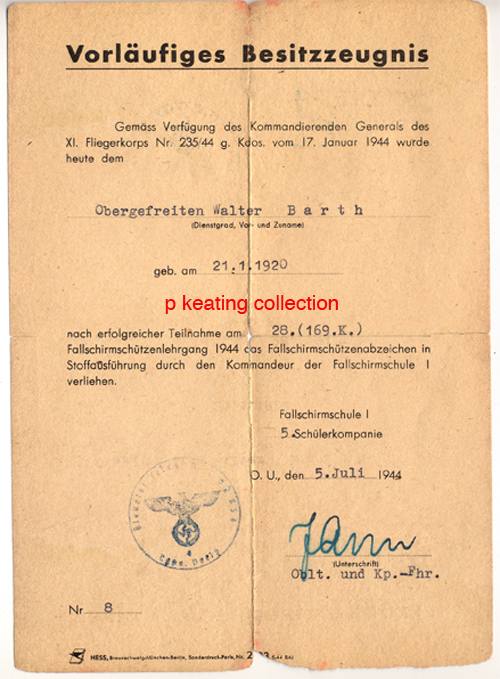
Here is a document group relating to an NCO medic from 5. Fallschirmj?ger-Division. Obergefreiter Walter Barth was awarded the Parachutist Badge on 5.7.1944 at Fallschirmschule I, based at Dreux some 75km due west of Paris. In fact, he was awarded the cloth version of the badge, as the document states. Barth must have been on one of the very last - if not the last - parachute training courses through the jump school at Dreux. They must have been able to hear the artillery at the front as they jumped. In fact, I'd imagine that everyone on board was thinking of Allied fighter planes as the Junker 52 or Heinkel HeIII climbed to jump height over the fields bordering the aerodrome!
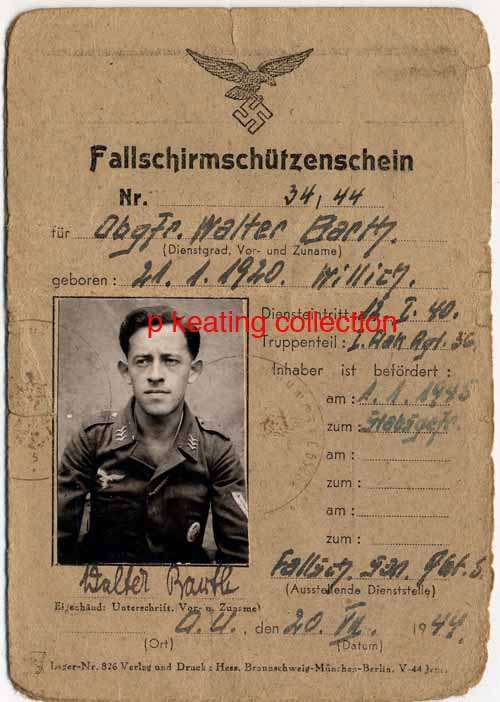

Barth, who had been with a Heavy Flak unit before his transfer to 5. Fallschirmj?ger-Division as a medic, was issued with his Military Parachutist Licence on 20.7.1944. Note that he is wearing the cloth badge awarded to him three weeks before at Dreux and that this FSS, which is the ultra-rare late war cardboard type, was issued to him at his unit in Normandy, during the heavy fighting there. Walter Barth, who would have been one of the last para-trained Fallschirmj?ger of WW2. By late July 1944, parachute training had been indefinitely suspended at all the schools in France (obviously!), Germany and Hungary. However, the Luftwaffe retained a limited parachute training capability until the end of 1944, as accounts of a very small number of men hastily trained for forward insertion during the Ardennes counter-offensive indicate. However, it is reasonable to say that parachute training per se was over by mid-July 1944. Oddly enough, a couple of veterans of SS-Fallschirmj?ger-Btl 500 who found themselves with the battalion's training company at the Hungarian airborne depot in Papa in July 1944 recalled watching with envy as Hungarian paras completed training jumps while they were unable to get the aircraft to do the jumps to earn their badges.
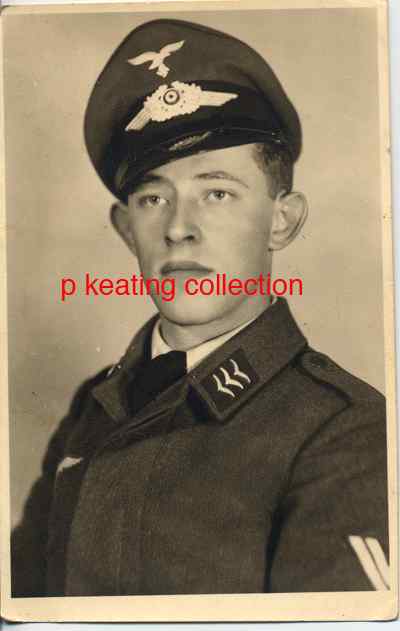
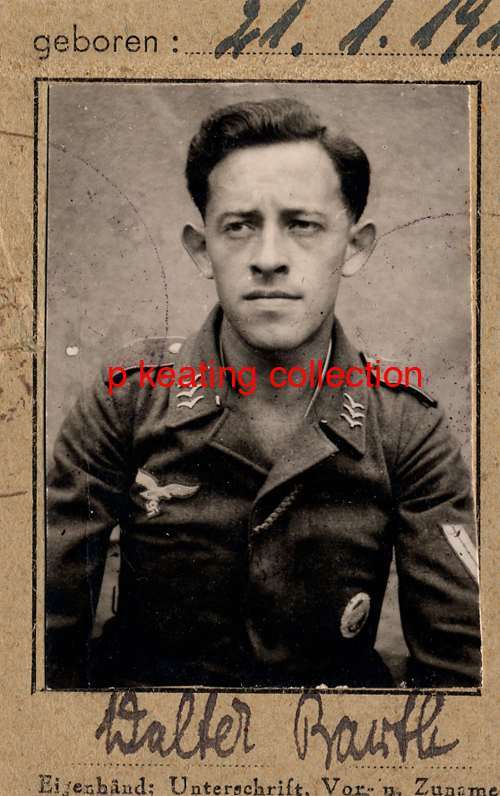
Compare these photographs of Barth to gain some idea of what the Normandy fighting was like. Coming back to the FSS, Walter Barth probably lost his soldbuch and other documents during the retreat from France as his FSS appears to have served as an ID document on which his promotion to Stabsgefreiter in January 1945 was recorded. Note also the entry for July 1945, closing off the document. This was when Barth and his surviving comrades from the rebuilt 5.FJD went into the bag.
Had your man joined the unit earlier, in the summer of 1944, it could easily have been the case that he qualified as a parachutist but that, like Barth, his paybook was lost, possibly captured by Allied forces overrunning 5. FJD?s positions in Normandy and during the retreat across the Seine, hence the lack of an entry for the Fallschirmsch?tzenschein. However, I doubt that this chap qualified as a parachutist. 5. FJD fought in the Ardennes at Bitburg, Donkholz and Martelange before being withdrawn for rest and refitting. Most of the division went surrendered in April 1945 in the Ruhr Pocket but some elements were still in the field when the final surrender was ordered.
It?s a perfectly good late war FJ paybook to a man in a unit that saw some hard fighting. I?ll bet he saw some hard fighting too. It is better than many late war paybooks, whose holders were only in FJ units for five minutes. As soon as I decipher his surname, I will run a check to see if he shows up in the war graves lists.
PK
0 -
This is interesting. Let me think about this and forumulate a reply.
PK
0 -
I think this is a post-1895 piece, Micha. It might even be 1914-1918. In general, the 1895-era crosses don't have the "old-fashioned" appearance of the 1870-1871 crosses. Mind you, some people would disagree with this and say that this cross was from the 1870s. I just don't think it is.
PK
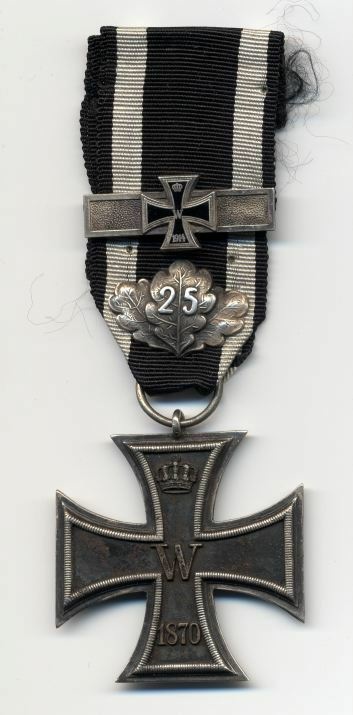
 0
0 -
Hmmmm. I knew of fellows who took part in some pretty hairy operations in Ulster back in the 1980s but who never got anything because they did not have enough days in the province to qualify for the CSM. And then there were the blokes who were in the Falklands who almost didn't get SAMs because the authorities decided that they were not there, even though they were very much there. Still, it's reassuring to see that some people are getting their dues. In fact, the medal office has given some veterans two and even three medals for Iraq, so we gather. Great! All the more for collectors...
PK
0 -
I've had a few Steinhauer & L?ck KVK1 over the years and can see nothing to indicate that this cross is not a textbook example. It looks just as it should look, IMHO. I don't know why the vendor misread the MM, though. The incuse '4' stamp is hard but not impossible to read with the naked eye. Perhaps he didn't have a jeweller's loup. Here are a couple of snapshots of one I had a few years ago. You can see that while it is in very good condition, a small ding to a point aside, oxidising solder can just been seen beginning to show through the finish.
PK
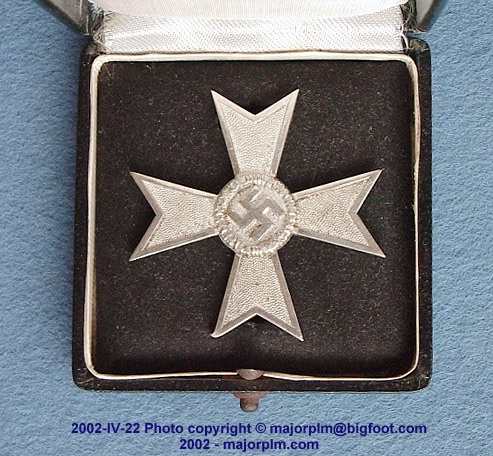


 0
0 -
That's why I collect documents and photography. One of these days, I will find an award document for Drvar to a member of SS-Fallschirmj?ger-Btl 500. I have documents to the battalion for other actions but, bizarrely, have never even seen any for Drvar. I have seen some fakes though! We'll round the Drvar part of this discussion off with a wartime print bearing Adolf Kunzmann's stamp on the reverse. It was taken early on the morning of 26.5.1944 on part of the defensive perimeter set up by the battalion the previous afternoon. This position overlooks one of the landing zones where you can see a couple of DFS230 assault gliders, as well as the smoke and flames from the fighting.
PK
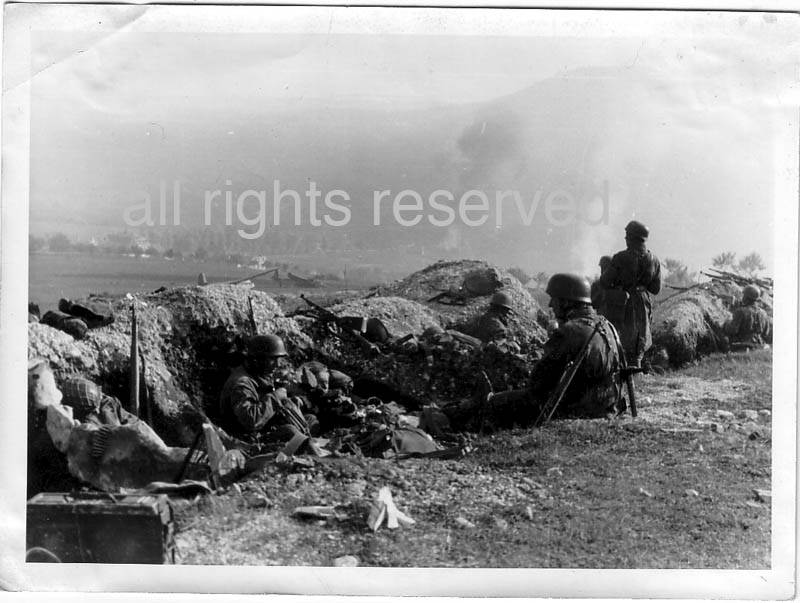
 0
0 -

A pleasure, gents. Here's another EK2 document that could well be for anti-partisan operations, namely the airlift on 25.5.1944 of SS-Fallschirmj?ger-Btl 500 to the Bosnian town of Drvar, where Tito had his HQ. If this is the case, then it could be said to be a Waffen-SS-related award.
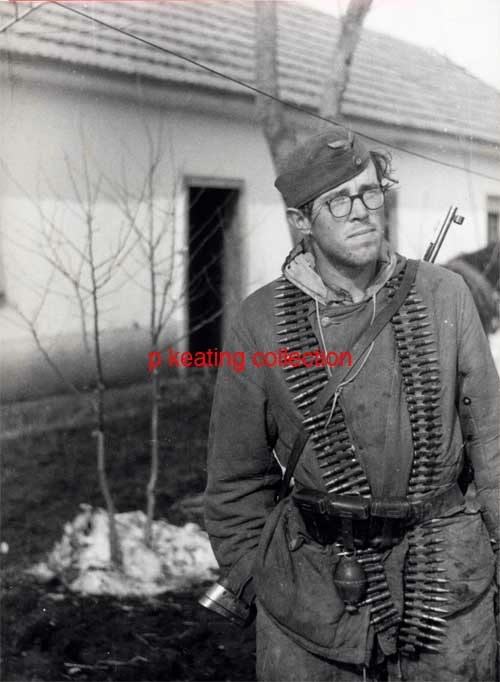
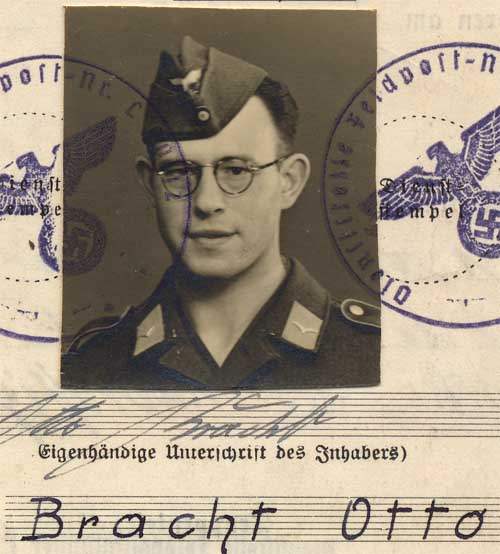
Here is glider pilot Otto Bracht. The fact that he wore glasses made it easier to pick him out one afternoon when I was poring over the Luftwaffe Kriegsberichter albums in the French military photo archives. LLG2 is not mentioned as participating in the Drvar mission but given that transport and glider pilots had to be drafted in from all over the place for the airborne assault, Bracht's EK2 could have been for Drvar, where the glider pilots fought on the ground during the ferocious twenty-four hour battle in and around the town.
On the other hand, Bracht was also in the Ukraine at some point during the winter of 1943/1944 as the photograph was apparently from a roll of film shot there by a Luftwaffe photo-reporter (kriegsberichter) of the Fallschirm-Propaganda-Kompanie attached to 2. Fallschirmj?ger-Division. 2. FJD had been transferred from Italy to the southern sector of the Eastern Front in November 1943. Or, rather, the rump of 2. FJD had been transferred to Shitomir, the rest being taken as cadre for the newly-forming 4. FJD. The heavily understrength division, comprising I./FJR2, III./FJR2, IV./FJR2, II./FJR5 and some supporting arms, fought at Shitomir and then at Kirovograd in January 1944. Retreating through Krioj Rog, Uman, Novgorodka and Kiev, April 1944 found the remnants of 2. FJD in the Kishinev zone, from where they were moved back to Germany for R&R and thence to Western France.
So, there are two possibilities: Bracht?s EK2 could have been for something he did when on the ground with 2. FJD in the southern USSR after airlanding reinforcements or supplies, perhaps during the Battle of Kirovograd, or it could have been for the Battle of Drvar on 25/26.5.1944. The OKW issued their Drvar communiqu? on 6.6.1944 and awards were made for Drvar on and around that date. If seconded to pilot a DFS 230 into Drvar, Bracht would have come from Hagenau and would have been back there by the evening of 26.5.1944 or the following day and from there to Istres when news of the Allied landings broke.
Otto Bracht could have been seconded for the Drvar operation on 25.5.1944. Although LLG2 was primarily equipped with the huge Gotha 242 gliders, they also flew DFS 230s and Bracht would have been DFS 230-qualified. As far as I know, glider pilots and other attached personnel were evacuated from Drvar shortly after the end of the battle on the morning of 26.5.1944. So his EK2 could easily have been for Drvar but issued by the FS-AOK in France, whose HQ was in Nancy, on 6.6.1944 along with other awards. The Luftwaffe awardee lists would have been telegrammed or telexed to local Luftwaffe headquarters so it would make sense. The document is handsigned by General Walter Lackner in the absence of Generaloberst Student.
3./LLG2 was formed in August 1942 as part of I./LLG2. From April to September 1943, I Gruppe was in southern France, based consecutively at Orange, Nancy and Istres. I Gruppe flew Heinkel He111 and Go242s. 3./LLG2 took eight Go242s to Naples on 11.9.1943 and from there to Catania on 13.7.1943. The rest of the Gruppe followed them on 14.7.1943 and airlifted 1. Fallschirmj?ger-Division?s heavy equipment to Sicily on 20.7.1943. However, 3./LLG2?s crews had returned to Istres on 19.7.1943. After airlifting elements of 2. Fallschirmj?ger-Division to Rome to disarm Italian forces early in August 1943, I./LLG2 returned to France and thence to Hagenau, in Germany, in September 1943, remaining there until June 1944, when they flew back to Istres. During this period, the squadron airlifted supplies and personnel to 2. FJD in November 1943 and it is hard not to believe that, held in reserve in France, LLG2 supplied men and aircraft for Drvar in May 1944. I./LLG2 left France in September 1944.


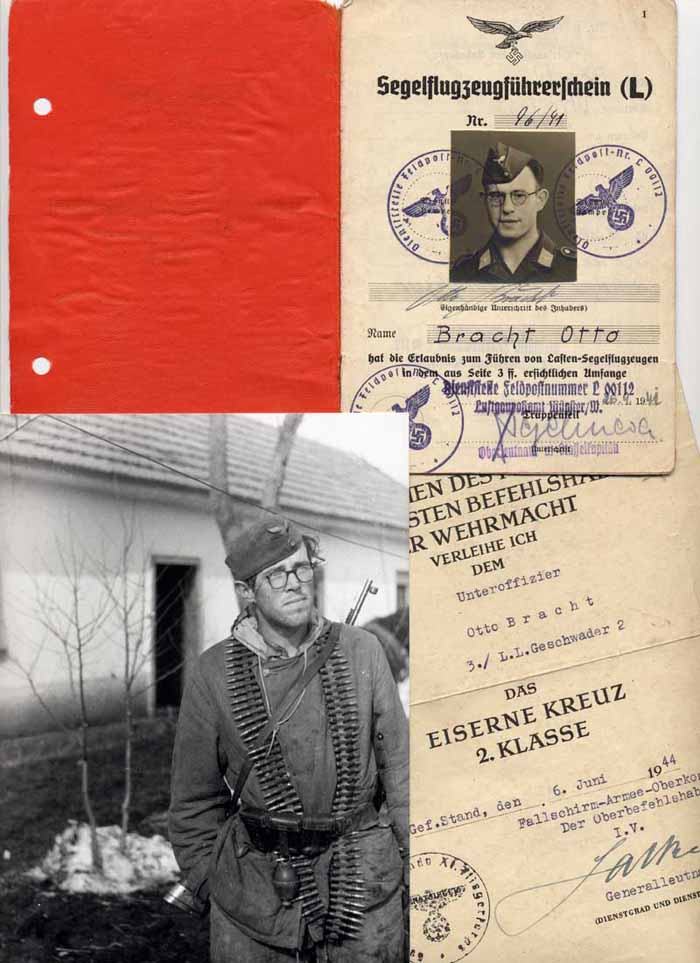
Even if the document is for the Ukraine, it is quite likely that Bracht met Soviet partisans during his time on the ground with 2. FJD, in addition to beating off spearhead Red Army penetrations. However, the 6.6.1944 date also fits very neatly with Drvar. I haven?t researched airlandings in the Ukraine during the fighting withdrawal in the winter of 1943/44 but if anyone has any information to share, I would be grateful to see it. Otto Bracht remained involved with gliding after the war: http://www.lsg-lippe.de/htm/ve_gesch.htm.
PK
0 -
Here's a nice Heer EK2 doc to a member of Festung-Infantry Battalion 1008. This unit retreated from Greece through Macedonia, western Serbia and Montenegro during October, November and December, 1944. Throughout this time, the unit engaged in fighting with Tito's patisans and the document is probably the result of these actions. It is signed by Generalleutnant Helmut Friebe of the 22nd Infantry Division. Festung Btallion served with the 22 ID (later 22. Volks-Grenadier-Division) until the end of the war. I'm pretty sure the division surrendered in Austria.
I like this doc because it is an award for fighting Partisans, not the traditional Allies. Also, it is somewhat interesting that the award date happens to be the same date as the launch of operation "die Wacht am Rhein". It's fun to think of what was going on on various fronts at the same time.
A very nice document indeed! Feldwebel Gaiser certainly won his EK for anti-partisan combat operations during the withdrawal. Quite a few members of Festungs-Inf.Btl. 1008 qualified for the Bandenkampfabzeichen as well. Judging by one soldbuch I saw, the unit was engaged in a lot of convoy protection duty during from October 1943 to November 1944. This makes sense, given the purpose of such units. People often pass over these documents because they do not rate fortress units but, as you say, a little bit of research often turns up trumps. Festungs-Inf.-Btl 1008 was part of Festungs-Infanterie-Rgt 938/41 which was stationed in the Pelloponese Mountains of southern Greece until July 1944, when the order to withdraw northwards came. The regiment marched north through Macedonia and then moved west through Serbia to Montenegro. In December 1944, the regiment was based in the Montenegran town of Prijepolje close to the current border with Bosnia, protecting the roads and railways against partisan attacks. I know this terrain very well and can tell you that Gaiser probably earned his EK2 the hard way. Festungs-Infanterie-Btl 1008 and its parent unit were then placed on the ORBAT of 22. ID, which was moving further north.
22. ID had been in Crete before evacuating the island and moving to the Greek mainland in October 1944. Not strictly relevant to the document but I'm sure you know that 22. ID was also known as 22. Luftlande-Infanterie-Division earlier in the war, participating with 7. Flieger-Division in the airborne operations in Holland and Crete. The division, no longer in the airborne or airlanding r?le, was later commanded from 1.3.1944 in Crete during a second operational tour there by Generalmajor Heinrich Kreipe, kidnapped on 26.4.1944 by Paddy Leigh-Fermor and Stanley Moss. Generalleutnant Friebe took over with effect from 1.5.1944 after Kreipe's capture. Captain Moss tried to kidnap Friebe two months later but was thwarted by understandably increased divisional security! Generalleutnant Helmut Friebe was a Ritterkreuztrager, like his more famous younger brother Werner, who ended the war as a Generalmajor. Here's a link to a website with photos of both brothers: http://www.specialcamp11.fsnet.co.uk/Gener...er%20Friebe.htm. Iron Cross collectors studying the portrait of Helmut Friebe will notice the first pattern 1939 Bar to the 1914 Iron Cross 1st Class with the curved edges to the date casette.
22. Infanterie-Division did not become 22. Volksgrenadier-Division until March 1945. The division ended the war in Slavonia with LXXXXI Korps z.b.V., protecting Heeresgruppe E's flank.
Hope this helps.
PK
0 -
Major (Retd) Heinrich Springer, who was one of the last two living Knight's Cross Holders from the Leibstandarte Adolf Hitler, has died. The colour photograph shows Springer, in the middle, during Fritz Witt's birthday party in France in 1944.
Heinrich Springer came from Kiel and joined the SS-Verf?gungstruppe in 1937. He served in the ranks in the Germania and Der F?hrer Regiments (Standarten) and participated in the Austrian and Sudetenland annexations. In 1938, he he was posted to the SS-Junkerschule in Bad T?lz, passing out as an SS-Untersturmf?hrer in October 1939. Posted to the LSSAH, Springer won the EK2 as a platoon commander at Dunkirk in 1940. Promoted to SS-Obersturmf?hrer in September 1940, he also fought in the Yugoslav and Greek campaigns.
During Barbarossa in July 1941, as Adjutant of 1./SS-Inf-Rgt (mot.) Leibstandarte Adolf Hitler, Springer was awarded the EK1 for his leadership of a patrol far behind Bolshevik lines, tasked with re-establishing contact with III Armee-Korps under General von Mackensen. By November 1941, SS-Hauptsturmf?hrer Springer was in command of 3./SS-Inf-Rgt (mot.) LAH when the company attacked and held a vital bridge over the Don river at Rostov in the face of concerted Bolshevik counter-attacks. Springer was wounded and evacuated. Whilst in hospital, he was awarded the Ritterkreuz in January 1942.
Returning to the LAH, he remained in command of 3./SS-Inf-Rgt (mot.) LAH until severely wounded by an artillery shell at Karkhov in March 1943. During his convalescence, he was promoted to Sturmbahnf?hrer and posted in October 1943 to the newly forming Hitlerjugend Division as Divisional Adjutant. Following the Normandy campaign, Springer was posted to the staff of Generalfeldmarschall Walter Model as First Ordnance Officer. Model was in command of Armeegruppe B and Springer saw action at Arnhem and during the Ardennes counter-offensive.
This is a just a brief biography. I am sure others can add more detail. Herr Springer was very much of the old school, extremely charming and solicitous yet rather formal at the same time, but very appreciative of young Europeans who took the trouble to get in touch with him in the days before veterans like him found themselves buried under tidal waves of requests for signed photos by people who then sold them on eBan. There came a time when Herr Springer, like other veterans, simply stopped responding to letters from people he did not know.
The funeral was private and, interestingly, Heinrich Springer's website http://www.heinrich-springer.de now leads to a German bookseller's webpage offering a biography of Springer. Springer was also a holder of the Wound Badge in Gold. There were not many soldiers on active service wearing that decoration.
Heinrich Springer RIP.
PK
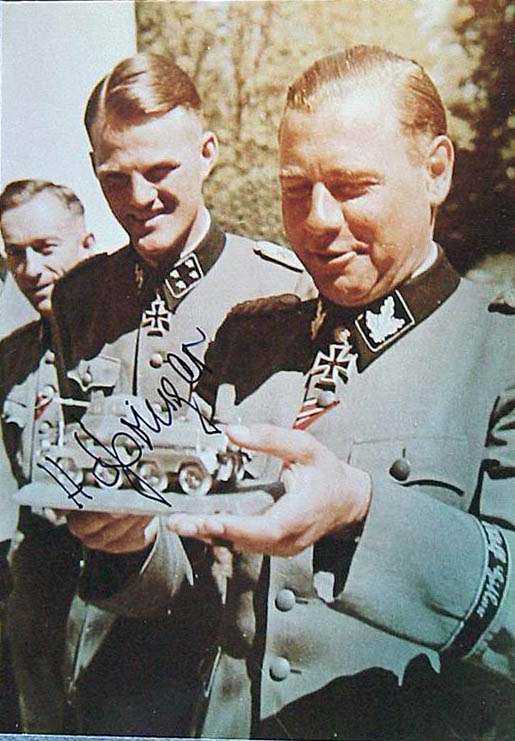
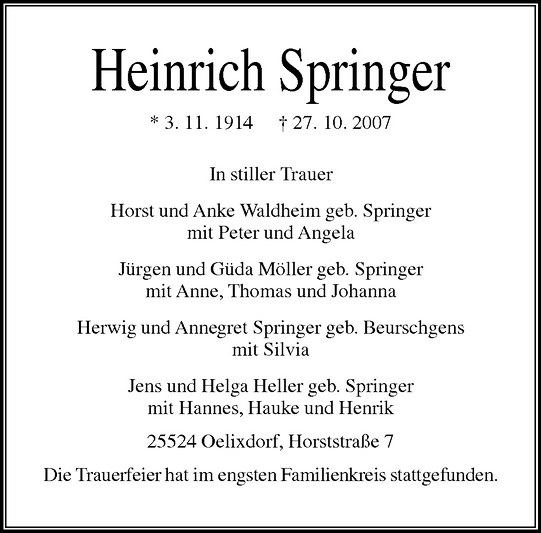

 0
0 -
Standard sources give this. British Battles and Medals, even Medals Yearbook. What else do you need to know?
This is a bit abrasive. The guy was asking a perfectly simple question. Maybe he doesn't have any reference books yet.
PK
0 -
I think there may have been a feeling that the Stars were to reward Regular soldiers, TAVR soldiers and volunteers, before conscription was brought in. I vaguely remember a very elderly collector telling me this over thirty years ago.
PK
0 -
That's a great story. Good on him and good on Oz.
P
0 -
Superb! Congratulations.
PK
0 -
Hi
PKeating
Nice photo and thank you for Sharing.(Is this photo from the Webbsit Infanteristurmbacheichen.de?).

Regards
Nesredep
I have never seen that website. I received this image from a friend and fellow FJ collector.
PK
0




Herr Artillery Badge, Real or Not?
in Germany: Third Reich: Wehrmacht Medals, Decorations & Awards
Posted
http://www.hessenantique.com/Army_Flak_Badge_p/haga018.htm
PK